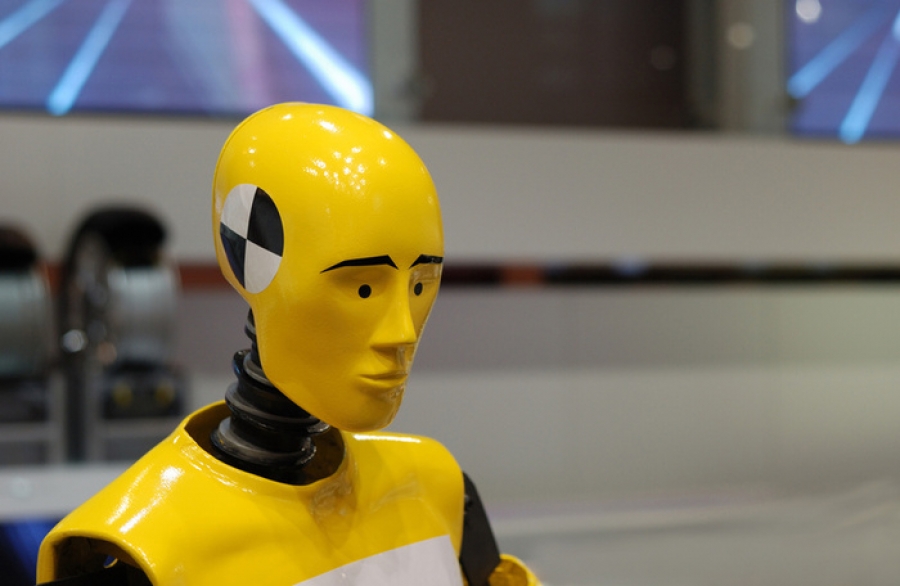Archive for the ‘How To’ Category
Lasting Behavioral Change
 Whether it’s innovation, creativity, continuous improvement, or discontinuous improvement, it’s all about cultural change, and cultural change is about change in behavior.
Whether it’s innovation, creativity, continuous improvement, or discontinuous improvement, it’s all about cultural change, and cultural change is about change in behavior.
With the police state approach, detailed processes are created and enforced; rules are created and monitored; and training is dealt out and attendance taken. Yes, behavior is changed, but it’s fleeting. Take your eye off the process, old behavior slips through the fence; look the other way from the rules, old behavior clips the barbed wire and climbs over the wall. To squelch old behavior with the police state approach, gulag energy must be consistently applied.
To squelch is one thing, but to create lasting behavior change is another altogether. But as different as they are, there’s a blurry line of justice that flips innocent to guilty. And to walk the line you’ve got to know where it is:
- Apply force, yes, but only enough to prevent backsliding – like a human ratchet. Push much harder and heels dig in.
- The only thing slower than going slow is going too fast. (Remember, you’re asking people to change the why of their behavior.) Go slow to go fast.
- Set direction and stay the course, unless there’s good reason to change. And when the team comes to you with a reason, deem it a good one, and the cornerstone of trust is laid. (This is a game of trust, not control.)
But there are some mantras to maximize:
- Over emphasize the positive and overlook the negative.
- Praise in public.
- Don’t talk, do.
The first two stand on their own, but the third deserves reinforcement.
This isn’t about your words, it’s about your behavior. And that’s good because you have full authority over your behavior. Demonstrate the new behavior so everyone knows what it looks like. Lead the way with your actions. Show them how it’s done. For lasting change, change your behavior.
Even if changing your behavior influences only one person, you’re on your way. The best prison riots start with a single punch.
Prototype the Unfamiliar
 Today’s answer to everything is process and tools. Define the desired outcome; create the process; create the tools. Problem solved.
Today’s answer to everything is process and tools. Define the desired outcome; create the process; create the tools. Problem solved.
But if the desired outcome is lasting change, deterministic processes and static tools won’t get us there. Lasting change comes from people and their behavior.
Going forward, instead of creating process, create an environment of trust so people will investigate the unfamiliar; and instead of creating tools, create time – time for people to prototype the unfamiliar.
A Race for Learning – Video Training with TED-Ed
 I’ve been thinking about how to use video to train engineers. The trouble with video is it takes time and money to create. But what if you could create lessons using existing video? That’s what the new TED-Ed platform can do. With TED-Ed, any YouTube video can be “flipped” into a customized lesson.
I’ve been thinking about how to use video to train engineers. The trouble with video is it takes time and money to create. But what if you could create lessons using existing video? That’s what the new TED-Ed platform can do. With TED-Ed, any YouTube video can be “flipped” into a customized lesson.
Instead of trying to describe it, I used the new platform to create a video lesson. Click the link below and give it a try. (The platform is still in beta version, so I’m not sure how will go. But that’s how it is with experiments.)
Video lesson: Innovation, Caveman-Style
When answering the questions, it may ask you to sign up for an account. Click the X in the upper right of the message to make it go away, and keep going. If the video does not work at all, poke around the TED-Ed website.
Either way, so we can accelerate our learning and get out in front, please post a comment or two.
Less-With-Far-Less for the Developing World
 The stalled world economy will make growth difficult, and companies are digging in for the long haul, getting ready to do more of what they do best – add more function and features, sell more into existing markets, and sell more to existing customers. More of the same, but better. But growth will not come easy with more-on-more thinking. It will be more-on-more trench warfare – ugly hand-to-hand combat with little ground gained. It’s time for another way. It’s time for less. It’s time to create new markets with less-with-far-less thinking.
The stalled world economy will make growth difficult, and companies are digging in for the long haul, getting ready to do more of what they do best – add more function and features, sell more into existing markets, and sell more to existing customers. More of the same, but better. But growth will not come easy with more-on-more thinking. It will be more-on-more trench warfare – ugly hand-to-hand combat with little ground gained. It’s time for another way. It’s time for less. It’s time to create new markets with less-with-far-less thinking.
Real growth will come from markets and consumers that don’t exist. Real (and big) growth will come from the developing world. They’re not buying now, but they will. They will when product are developed that fit them. But here’s the kicker – products for the developed world cannot be twisted and tweaked to fit. Your products must be re-imagined.
The fundamentals are different in the developing world. Three important ones are – ability to pay, population density, and literacy/skill.
The most important fundamental is the developing world’s ability to pay. They will buy, but to buy products must cost 10 to 100 times less. (No typo here – 10 to 100 times less.) Traditional cost reduction approaches such as Design for Manufacturing and Assembly (DFMA) won’t cut it – their 50% cost reductions are not even close. Reinvention is needed; radical innovation is needed; fundamental innovation is needed. Less-with-far-less thinking is needed.
To achieve 10-100X cost reductions, the product must do less and do it far more efficiency (with far less). Product functionality must be decimated – ripped off the bone until only bone remains. The product must do only one thing. Not two – one. The product must be stripped to its essence, and new technology must be developed to radically improve efficiency of delivering its essence. Products for the developing world will require higher levels of technology than products for the developed world.
Radical narrowing of functionality will make viable the smaller, immature, more efficient technologies. Infant technologies usually have lower output and less breadth, but that’s just what’s needed – narrow, deep, and less. Less-with-far-less.
In the developing world, population density is low. People are spread out, and rural is the norm. And it’s not developed world rural, it’s three-day-hike rural. In the developing world, people don’t go to products; products go to people. If it’s not portable, it won’t sell. And developing world portable does not mean wheels – it means backpack. Your products must fit in a backpack and must be light enough to carry in one.
Big, stationary, expensive equipment is not exempt. It also must fit in a backpack. And this cannot be achieved with twist-and-bend engineering. To fit in a backpack, the product must be stripped naked and new technology must be developed to radically improve efficiency. This requires radical narrowing, radical reimagining, and radical innovation. It requires less-with-far-less thinking. (And if it doesn’t run on batteries, it should at least have battery backup to deal with rolling blackouts.)
People in the developing world are intelligent, but most cannot read well and have little experience with developed world products. Where the developed world’s solution is picture-based installation instructions, less-with-far-less products for the developing world demand no instructions. For the developing world, the instruction manual is the on button. And this requires serious technology – software algorithms fed by low cost sensors. And the only way it’s possible is by distilling the product to its essence. Algorithms, yes, but algorithms to do only one thing very well. Less-with-far-less.
The developed world makes products with output that requires judgment – multi-colored graphical output that lets the user decide if things went well. Products for the developing world must have binary output – red/green, beep/no-beep. Less-with-far-less. But again, this seemingly lower-level functionality (a green light versus a digital display) actually requires more technology. The product must interpret results and decide if it’s good – much harder than a sexy graphical output that requires interpretation and judgement.
Creating products for the developing world requires different thinking. Instead of adding more functions and features, it’s about creating new technologies that do one thing very well (and nothing more) and do it with super efficiency. Products for the developing world require higher technologies than those for the developed world. And done well, the developed world will buy them. But the crazy thing is, the less-with-far-less products that will be a hit in the developing world will boomerang back and be an even bigger hit in the developed world.
How To Accelerate Engineers Into Social Media
 Engineers fear social media, but shouldn’t. Our fear comes from lack of knowledge around information flow. Because we don’t understand how information flow works, we stay away. But our fear is misplaced – with social media information flow is controllable.
Engineers fear social media, but shouldn’t. Our fear comes from lack of knowledge around information flow. Because we don’t understand how information flow works, we stay away. But our fear is misplaced – with social media information flow is controllable.
For engineers, one-way communication is the best way to start. Engineers should turn on the information tap and let information flow to them. Let the learning begin.
At first, stay away from FaceBook – it’s the most social (non-work feel), least structured, and most difficult to understand – at least to me.
To start, I suggest LinkedIn – it’s the least social (most work-like) and highly controllable. It’s simple to start – create an account, populate your “resume stuff” (as little as you like) and add some connections (people you know and trust). You now have a professional network who can see your resume stuff and they can see yours. But no one else can, unless you let them. Now the fun part – find and join a working group in your interest area. A working group is group of like-minded people who create work-related discussions on a specific topic. Mine is called Systematic DFMA Deployment. You can search for a group, join (some require permission from the organizer), and start reading the discussions. The focused nature of the groups is comforting and you can read discussions without sharing any personal information. To start two-way communication, you can comment on a discussion.
After LinkedIn, engineers should try Twitter. Tweets (sounds funny, doesn’t it?) are sentences (text only) that are limited to 140 characters. With Twitter, one-way communication is the way to start – no need to share information. Just create an account and you’re ready to learn. With LinkedIn it’s about working groups, and with Twitter it’s about hashtags (#). Hashtags create focus with Twitter and make it searchable. For example, if the tweet creator uses #DFMA in the sentences, you can find it. Search for #DFMA and you’ll find tweets (sub-140 character sentences) related to design for manufacturing and assembly. When you find a hashtag of interest, monitor those tweets. (You can automate hashtag searches – HootSuite – but that’s for later). And when you find someone who consistently creates great content, you can follow them. Once followed, all their tweets are sent to your Twitter account (Twitter feed). To start two-way communication you can retweet (resend a tweet you like), send a direct message to someone (like a short email), or create your own tweet.
Twitter’s format comforts me – short, dense bursts of sentences and no more. Long tweets are not possible. But a tweet can contain a link to a website which points to a specific page on the web. To me it’s a great combination – short sentences that precisely point to the web.
With engineers and social media, the goal is to converge on collaboration. Ultimately, engineers move from one-way communication to two-way communication, and then to collaboration. Collaboration on LinkedIn and Twitter allows engineers to learn from (and interact with) the world’s best subject matter experts. Let me say that again – with LinkedIn and Twitter, engineers get the latest technical data, analyses, and tools from the best people in the world. And it’s all for free.
For engineers, social and media are the wrong words. For engineers, the right words are – controlled, focused, work-related information flow. And when engineers get comfortable with information flow, they’ll converge on collaboration. And with collaboration, engineers will learn from each other, help each other, innovate and, even, create personal relationships with each other.
Companies still look at social media as a waste of work time, and that’s especially true when it comes to their engineers. But that’s old thinking. More bluntly, that’s dangerous thinking. When their engineers use social media, companies will develop better products and technologies and commercialize them faster.
Plain and simple, companies that accelerate their engineers into social media will win.
Win Hearts and Minds
 As an engineering leader you have the biggest profit lever in the company. You lead the engineering teams, and the engineering teams design the products. You can shape their work, you can help them raise their game, and you can help them change their thinking. But if you don’t win their hearts and minds, you have nothing.
As an engineering leader you have the biggest profit lever in the company. You lead the engineering teams, and the engineering teams design the products. You can shape their work, you can help them raise their game, and you can help them change their thinking. But if you don’t win their hearts and minds, you have nothing.
Engineers must see your intentions are good, you must say what you do and do what you say, and you must be in it for the long haul. And over time, as they trust, the profit lever grows into effectiveness. But if you don’t earn their trust, you have nothing.
But even with trust, you must be light on the tiller. Engineers don’t like change (we’re risk reducing beings), but change is a must. But go too quickly, and you’ll go too slowly. You must balance praise of success with praise of new thinking and create a standing-on-the-shoulders-of-giants mindset. But this is a challenge because they are the giants – you’re asking them to stand on their own shoulders.
How do you know they’re ready for new thinking? They’re ready when they’re willing to obsolete their best work and to change their work to make it happen. Strangely, they don’t need to believe it’s possible – they only need to believe in you.
Now the tough part: There’s a lot of new thinking out there. Which to choose?
Whatever the new thinking, it must make sense at a visceral level, and it must be simple. (But not simplistic.) Don’t worry if you don’t yet have your new thinking; it will come. As a seed, here are my top three new thinkings:
Define the problem. This one cuts across everything we do, yet most underwhelm it. To get there, ask your engineers to define their problems on one page. (Not five, one.) Ask them to use sketches, cartoons, block diagram, arrows, and simple nouns and verbs. When they explain the problem on one page, they understand the problem. When they need two, they don’t.
Test to failure. This one’s subtle but powerful. Test to define product limits, and don’t stop until it breaks. No failure, no learning. To get there, resurrect the venerable test-break-fix cycle and do it until you run out of time (product launch.) Break the old product, test-break-fix the new product until it’s better.
Simplify the product. This is where the money is. Product complexity drives organizational complexity – simplify the product and simply everything. To get there, set a goal for 50% part count reduction, train on Design for Assembly (DFA), and ask engineering for part count data at every design review.
I challenge you to challenge yourself: I challenge you to define new thinking; I challenge you to help them with it; I challenge you to win their hearts and minds.
Fix The Economy – Connect The Engineer To The Factory
 Rumor has it, manufacturing is back. Yes, manufacturing jobs are coming back, but they’re coming back in dribbles. (They left in a geyser, so we still have much to do.) What we need is a fire hose of new manufacturing jobs.
Rumor has it, manufacturing is back. Yes, manufacturing jobs are coming back, but they’re coming back in dribbles. (They left in a geyser, so we still have much to do.) What we need is a fire hose of new manufacturing jobs.
Manufacturing jobs are trickling back from low cost countries because companies now realize the promised labor savings are not there and neither is product quality. But a trickle isn’t good enough; we need to turn the tide; we need the Mississippi river.
For flow like that we need a fundamental change. We need labor costs so low our focus becomes good quality; labor costs so low our focus becomes speed to market; labor costs so low our focus becomes speed to customer. But the secret is not labor rate. In fact, the secret isn’t even in the factory.
The secret is a secret because we’ve mistakenly mapped manufacturing solely to making (to factories). We’ve forgotten manufacturing is about designing and making. And that’s the secret: designing – adding product thinking to the mix. Design out the labor.
There are many names for designing and making done together. Most commonly it’s called concurrent engineering. Though seemingly innocuous, taken together, those words have over a thousand meanings layered with even more nuances. (Ask someone for a simple description of concurrent engineering. You’ll see.) It’s time to take a step back and demystify designing and making done together. We can do this with two simple questions:
- What behavior do we want?
- How do we get it?
What’s the behavior we want? We want design engineers to understand what drives cost in the factory (and suppliers’ factories) and design out cost. In short, we want to connect the engineer to the factory.
Great idea. But what if the factory and engineer are separated by geography? How do we get the behavior we want? We need to create a stand-in for the factory, a factory surrogate, and connect the engineer to the surrogate. And that surrogate is cost. (Cost is realized in the factory.) We get the desired behavior when we connect the engineer to cost.
When we make engineering responsible for cost (connect them to cost), they must figure out where the cost is so they can design it out. And when they figure out where the cost is, they’re effectively connected to the factory.
But the engineers don’t need to understand the whole factory (or supply chain), they only need to understand places that create cost (where the cost is.) To understand where cost is, they must look to the baseline product – the one you’re making today. To help them understand supply chain costs, ask for a Pareto chart of cost by part number for purchased parts. (The engineers will use cost to connect to suppliers’ factories.) The new design will focus on the big bars on the left of the Pareto – where the supply chain cost is.
To help them understand your factory’s cost, they must make two more Paretos. The first one is a Pareto of part count by major subassembly. Factory costs are high where the parts are – time to put them together. The second is a Pareto chart of process times. Factory costs are high where the time is – machine capacity, machine operators, and floor space.
To make it stick, use design reviews. At the first design review – where their design approach is defined – ask engineering for the three Paretos for the baseline product. Use the Pareto data to set a cost reduction goal of 50% (It will be easily achieved, but not easily believed.) and part count reduction goal of 50%. (Easily achieved.) Here’s a hint for the design review – their design approach should be strongly shaped by the Paretos.
Going forward, at every design review, ask engineering to present the three Paretos (for the new design) and cost and part count data (for the new design.) Engineering must present the data themselves; otherwise they’ll disconnect themselves from the factory.
To seal the deal, just before full production, engineering should present the go-to-production Paretos, cost, and part count data.
What I’ve described may not be concurrent engineering, but it’s the most profitable activity you’ll ever do. And, as a nice side benefit, you’ll help turn around the economy one company at a time.
Stop Doing – it will double your productivity
 For the foreseeable future, there will be more work than time. Yet year-on-year we’re asked to get more done and year-on-year we pull it off. Most are already at our maximum hour threshold, so more hours is not the answer. The answer is productivity.
For the foreseeable future, there will be more work than time. Yet year-on-year we’re asked to get more done and year-on-year we pull it off. Most are already at our maximum hour threshold, so more hours is not the answer. The answer is productivity.
Like it or not, there are physical limits to the number of hours worked. At a reasonable upper our bodies need sleep and our families deserve our time. And at the upper upper end, a 25 hour day is not possible. Point is, at some point we draw a line in the sand and head home for the day. Point is, we have finite capacity.
As a thought experiment, pretend you’re at (or slightly beyond) your reasonable upper limit and not going to work more hours. If your work stays the same, your output will be constant and productivity will be zero. But since productivity will increase, your work must change. No magic here, but how to change your work?
Changing your work is about choice – the choice to change your work. You know your work best and you’re the best one to choose. And your choice comes down to what you’ll stop doing.
The easiest thing to stop doing is work you’ve just completed. It’s done, so stop. Finish one, start one is the simplest way to go through life, but it’s not realistic (and productivity does not increase.) Still, it makes for a good mantra: Stop starting and start finishing.
The next things to stop are activities that have no value. Stop surfing and stop playing Angry Birds. Enough said. (If you need professional help to curb your surfing habit, take a look at Leechblock. It helped me.)
The next things to stop are meetings. Here are some guidelines:
- If the meeting is not worth a meeting agenda, don’t go.
- If it’s a status meeting, don’t go – read the minutes.
- If you’re giving status at a status meeting, don’t go – write a short report.
- If there’s a decision to be made, and it affects you, go.
The next thing to stop is email. The best way I know to kick the habit is a self-mandated time limit. Here are some specific suggestions:
- Don’t automatically connect your email to the server – make yourself connect to it.
- Create an email filter for the top ten most important people (You know who they are.) to route them to your Main inbox. Everyone else is routed to a Read Later inbox.
- Check email for fifteen minutes in the morning and fifteen minutes in the afternoon. Start with the Main inbox (important people) and move to the Read Later inbox if you have time. If you don’t have time for the Read Laters, that’s okay – read them later.
- Create an email rule that automatically deletes unread emails in two days and read ones in one.
- Let bad things happen and adjust your email filters and rules accordingly.
Once you’ve chosen to stop the non-productive work, you’ll have more than doubled your productive hours which will double your productivity. That’s huge.
The tough choices come when you must choose between two (or more) sanctioned projects. There are also tricks for that, but that’s different post.
Heroes of the Company
 If I was a company, the first thing I’d do is invest in my engineering teams. But not for the reasons we normally associate with engineering. Not for more function and features, not for product robustness, not technology, and not patents. I would invest in engineering for increased profits.
If I was a company, the first thing I’d do is invest in my engineering teams. But not for the reasons we normally associate with engineering. Not for more function and features, not for product robustness, not technology, and not patents. I would invest in engineering for increased profits.
When it comes to their engineering divisions, other companies think minimization – fewest heads, lowest wages, least expensive tools. Not me. I’m all about maximization – smartest, best trained, and the best tools. That’s how I like to maximize profits. To me, investing in my engineering teams gives me the highest return on my investment.
Engineers create the products I sell to my customers. I’ve found when my best engineers sit down and think for a while they come up with magical ideas that translate into super-performing products, products with features that differentiate me from my cousin companies, and products that flat-out don’t break. My sales teams love to sell them (Sure, I pay a lot in bonuses, but it’s worth it.), my marketing teams love to market them, and my factory folks build them with a smile.
Over my life I’ve developed some simple truisms that I live by: When I sell more products, I make more profits; when my products allow a differentiated marketing message, I sell more and make more profits; and when my product jumps together, my quality is better, and, you guessed it, I make more profits. All these are good reasons to invest in engineering, but it’s not my reason. All this increased sales stuff is good, but it’s not great. It’s not my real reason to invest in engineering. It’s not my secret.
When I was younger I vowed to take my secret to the grave, but now that I’ve matured (and filled up several banks with money), I think it’s okay to share it. So, here goes.
My real reason to invest in engineering is material cost reduction. Yes, material cost reduction. My materials budget is one of my largest line items and I help my engineers reduce it with reckless abandon (and the right tools, time, training, and teacher.) I’ve asked my lean folks to reduce material cost, but they’ve not been able to dent it. Sure, they’ve done a super job with inventory reduction (I get a one-time carrying cost reduction.), but no material cost reduction from my lean projects. I’ve also asked my six sigma organization to reduce material costs, but they, too, have not made a dent. They’ve improved my product quality, but that doesn’t translate into piles of money like material cost reduction.
Now, I know what you’re thinking: Why, Mrs. Company, are you wasting engineering’s time with cost? Cost is manufacturing’s responsibility – they should reduce it, not engineering. Plain and simple – that’s not what I believe, and neither do my engineers. They know they create cost to enable function, good material cost – worth every penny. But they also know all other cost is bad. And since they know they design in cost, they know they’re the ones that must design it out. And they’re good at it. With the right tools, time, and training, they typically reduce material costs by 50%. Do the math –material cost for your highest volume product times 50% – year-on-year. Piles of money.
I’ve learned over the years increasing sales is difficult and takes a lot of work. I’ve also learned I can make lots of money reducing material costs without increasing sales. In fact, even during the recent downturn, through my material cost reductions I made more money than ever. I have my design engineers to thank for that.
Company-to-company, I know things have been tough for us over the last years, and money is still tight. But if you have a little extra stashed away, I urge you to invest in your engineering organization. It makes for great profits.
Lean and Supply Chain Sensitivity
 At every turn, lean has increased profits in the factory. Its best trick is to look at the work through a time lens, see wasted time, and get rid of it.
At every turn, lean has increased profits in the factory. Its best trick is to look at the work through a time lens, see wasted time, and get rid of it.
Work is blocked by problems. You watch the work to spot blockages in the form of piles, otherwise known as inventory. When you find a pile, you know the problem is one operation downstream.
As lean works its magic, inventory is reduced, which decreases carrying costs. More importantly, however, it also reduces the time to see a problem. Whether the problem is related to quality, delivery or resources, everything stops immediately. It’s clear what to fix, and there’s incentive to fix it quickly because with lean, the factory is more sensitive to problems.
What works in the factory will also work in the supply chain, and that’s where lean is going.
A Recipe for Unreasonable Profits
 There’s an unnatural attraction to lean – a methodology to change the value stream to reduce waste. And it’s the same with Design for Manufacturing (DFM) – a methodology to design out cost of your piece-parts. The real rain maker is Design for Assembly (DFA) which eliminates parts altogether (50% reductions are commonplace.) DFA is far more powerful.
There’s an unnatural attraction to lean – a methodology to change the value stream to reduce waste. And it’s the same with Design for Manufacturing (DFM) – a methodology to design out cost of your piece-parts. The real rain maker is Design for Assembly (DFA) which eliminates parts altogether (50% reductions are commonplace.) DFA is far more powerful.
The cost for a designed out part is zero. Floor space for a designed out part is zero. Transportation cost for a designed out part is zero. (Can you say Green?) From a lean perspective, for a designed out part there is zero waste. For a designed out part the seven wastes do not apply.
Here’s a recipe for unreasonable profits:
Design out half the parts with DFA. For the ones that remain, choose the three highest cost parts and design out the cost. Then, and only then, do lean on the manufacturing processes.
For a video version of the post, see this link: (Video embedded below.)
A Recipe for Unreasonable Profits.
 Mike Shipulski
Mike Shipulski